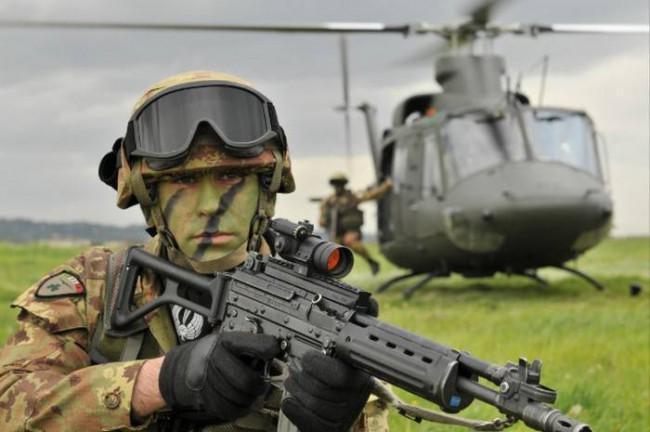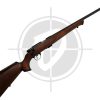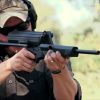The Beretta 70/90 system was developed to meet the Italian Army’s requirements for a modern assault rifle and was taken into service in 1990. Development of the Beretta 70/90 system began in the 1980s when the Italian Government decided that it’s military and law enforcement agencies needed a new standard service weapon.
Beretta System
The system consists of four weapons:
- assault rifle AR70/90 for infantry
- carbine SC70/90 for Special Forces
- special carbine (short) SCS70/90 for mechanized troops,
- light machine gun AS70/90 for use as the infantry squad automatic weapon
Design
The Beretta AR70/90 is an improved version of an earlier 5.56 mm design, the 70/223, and its design was influenced by experience with that weapon. Specific weaknesses in the earlier design were corrected, and many new features were introduced. It is a traditional rifle in use by the Italian armed forces.
The method of operation is the usual modern system of a bolt carrier with a rotating bolt driven by a gas piston mounted in a cylinder above the barrel. As the gas follows the bullet up the barrel, a small amount is tapped off to backward the piston.

This pushes the bolt carrier, and a cam path in the carrier rotates the bolt to unlock it, after which carrier and bolt run back, extracting the empty case and ejecting it. A spring then drives the carrier and piston forward again, collecting a cartridge from the magazine and chambering it, and as the carrier comes to rest, the cam rotates the bolt to lock it into the chamber. A hammer mechanism, controlled by the trigger, is left cocked, ready to fire.

The trigger mechanism has a selector lever that allows single shots, three-round bursts for a single trigger pressure, or sustained automatic fire. Optionally, fire can be restricted to single shots and three-round bursts.
Super improved version of AK-47
The Beretta AR70/90 used a bunch of places in small quantities, but notably, the issue rifles of the Italians until recently are in many ways super refined AK-47s. The rifle feeds from a 30-round magazine, and the magazine housing is NATO-standard to accept magazines from other NATO-standard rifles such as the M16 or the British L85.
A carrying handle is fitted above the receiver, clipped in place, and holding a luminous source for illuminating the sights at night. The handle can be removed, leaving a dovetailed receiver cover that will accept most types of night vision or telescopic sight.
Variants
The carbine SC70/90 differs from the rifle only in having a folding butt, while the shorter carbine SCS70/90 also has a shorter barrel and is thus slightly lighter. The machine gun version AR70/90 has a heavier barrel, surrounded by a perforated handguard, fixing points for vehicle or tripod mounting, a bipod folded beneath the handguard, and a different butt with a shoulder rest and facilities for gripping it more firmly.

As with the rifle and carbines, it is possible to launch grenades from the machine gun’s muzzle.
Rifle’s successor
In 2008, the Italian Armed Forces initiated the layered Soldato Futuro (Future Soldier) program, which sought to modernize the elements of the Armed Forces following the wake of innovations and battlefield experiences in the 2000s. One of the program’s perimeters examined a potential replacement/upgrade for the Beretta AR70/90.
Beretta began to develop an upgraded version of the Beretta AR70/90 platform. Still, the product in development would eventually evolve into the Beretta ARX-160, which would be chosen as AR70/90’s successor as the standard assault rifle of the Italian Armed Forces.
Technical specifications: Beretta AR70/90
| Manufacturer: | Armi Beretta SpA, I-25063, Gardone Val Trompia, Italy |
| Type: | gas-operated, selective fire |
| Caliber: | 5.56 mm (.223) |
| Barrel: | 17.7 in (450 mm) |
| Weight (empty): | 8.4 lbs (3.8 kg) |
| Magazine capacity: | 30 rounds |





